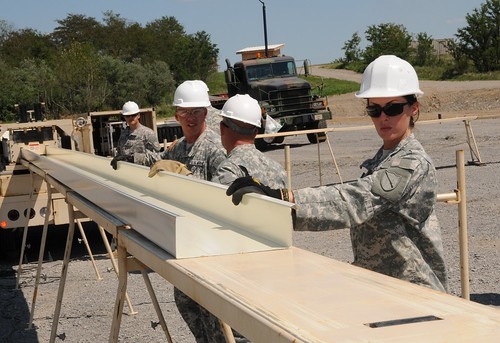Story and photos by Sgt. Scott Raymond, Kentucky National Guard Public Affairs Office
[caption id="" align="alignright" width="360"]

Spc. Roscoe Click, Spc. Matthew Peck and Sgt. Joshua Brown, all of the 149th Vertical Engineer Co., curve steel panels to form a section of a roof for a K-span building at Wendell H. Ford Regional Training Center in Greenville, Ky., Aug. 20, 2012. (Kentucky National Guard photo by Sgt. Scott Raymond)
GREENVILLE, Ky. -- Soldiers of the 149th Vertical Engineer Company donned their construction hats recently to take on the assembly of new structures at Wendell H. Ford Regional Training Center (WHFRTC) in Greenville, Ky. Set in the rolling landscape of Muhlenburg County, a new Contingency Operating Location (COL) is is taking shape for the training site and the Kentucky Guard.
The buildings the 149th are erecting at WHFRTC not only benefit their own skill set, but also the training possibilities for servicemembers in the Commonwealth.
"These buildings are just another example of the growth and potential we are seeing here," said State Command Sgt. Maj. Gregory Armstrong. "We are building to benefit all Soldiers and Airman utilizing this facility, and the more we have to offer, the greater impact will be on those who come to train at the Wendell Ford Regional Training Center."
To see more photos from the 149th's construction, click here
[caption id="" align="alignleft" width="350"]

Soldiers of the 149th Vertical Engineer Co. assemble steel panels to lift into position as the roof of a K-span building at Wendell H. Ford Regional Training Center in Greenville, Ky., Aug. 20, 2012. (Kentucky National Guard photo by Sgt. Scott Raymond)
The arched steel buildings, commonly referred to as K-spans, will add to the training site's growing capabilities to house, support and train servicemembers who utilize the area. Once completed the buildings may be used for maintenance bays, barracks and/or storage.
Armstrong also noted the importance of utilizing the Kentucky Guard's own construction engineers, saying it drastically reduces construction costs while also refining and honing the Soldier's occupational skills.
The engineers of the 149th are all too familiar with the COL site, as they were on ground in May to construct several sea-huts which were the first structures built at the location. But since sea-huts are made of wood, and the K-spans are an unfamiliar assortment of concrete and steel, the unit needed its own instruction on the process. A civilian contractor was brought in to teach the Soldiers the proper way of erecting K-spans during a two-week class.
The course was hands on immediately, with a lot of information put out to the engineers quickly, said 1st Lt. Michael Hamblin, the project officer in charge from Lexington, Ky.
"We learned so much in a short amount of time," he said. "But within one week, we could clearly see how all the pieces would come together."
[caption id="" align="alignright" width="300"]

Spc. Rachel Marcum from Louisa, Ky., with the 149th Vertical Engineer Co., guides a steel panel from an automatic building machine during a construction course at Wendell H. Ford Regional Training Center in Greenville, Ky., Aug. 20, 2012. (Kentucky National Guard photo by Sgt. Scott Raymond)
Starting with a concrete foundation, rolls of steel were formed, cut and shaped into curved panels by an automatic building machine. Soldiers then stacked the panels and connected them to form a section of the roof which is then raised into position by a crane. The sections are secured to the foundation and the process is repeated until the structure is complete.
The method of constructing K-spans could allow from a 12-foot building to much larger dual-story structures. Hamblin said K-spans are built to last and easier to maintain, making them a suitable option for military construction both at home and abroad.
"This is great training for us to have," said Hamblin. "With 30 more Soldiers qualified to do this, we're able to go more places."
Sgt. Timothy Shanks has nearly 20 years of experience in home construction, and the course was all new to him as well. He said setting up the sea-huts were more his style, with all the wood and traditional building methods, but the K-spans were completely different.
"It's very interesting to me," said the Paris, Ky., native. "I've learned a lot of new stuff here, and it's good to learn."
The knowledge may be of great value to the unit as they may be called upon to build just such structures during their scheduled deployment to Afghanistan next year. The veteran Shanks knows all too well the benefit of learning prior to going overseas.
"It's good to know how to do this now, so we are more than prepared to do it in a combat zone."